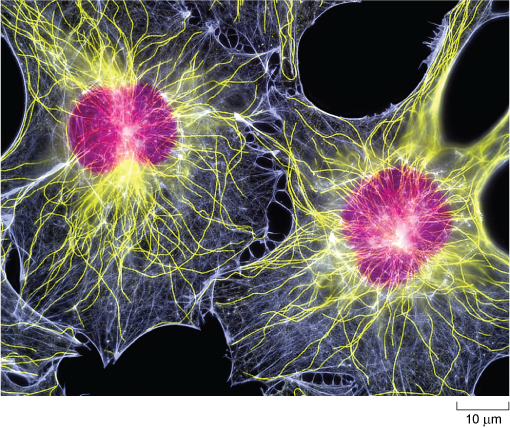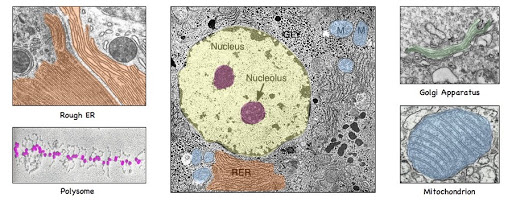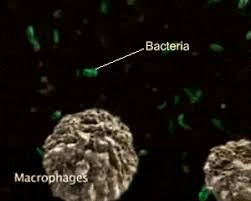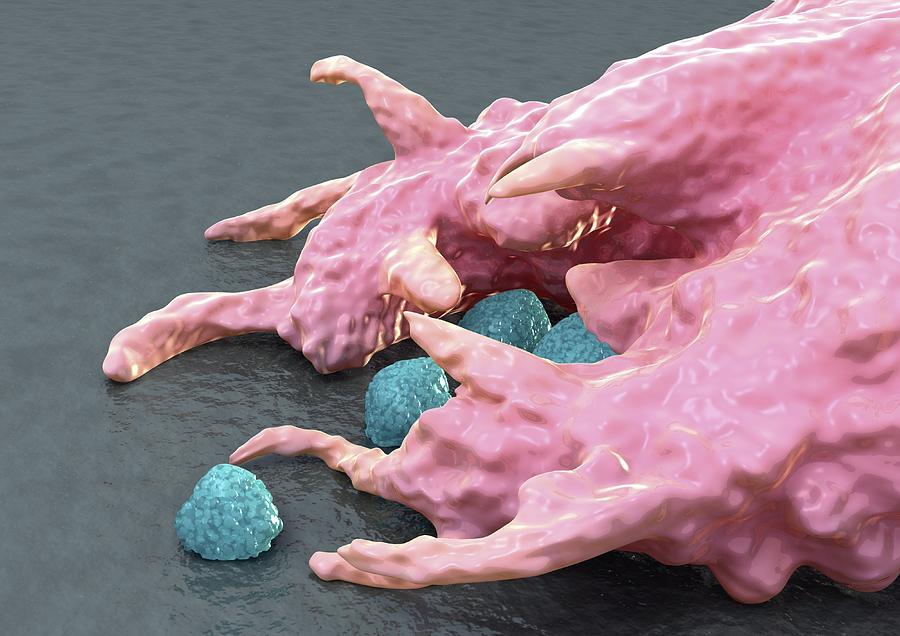

I recommend you do a 'google' 'images' search for pictures and diagrams of a specific cell structure.

Macrophage eating a bacterial cell

Macrophage eating a bacterial cell
Nucleolus: Ribosome synthesis occurs in special regions of the nucleus called nucleoli (singular = nucleolus).
Most eukaryotic genomes contain large numbers of copies of the genes for ribosomal RNAs, and these are clustered in
the nucleolus. Here enzymes and other proteins facilitate rRNA transcription, and it is within nucleoli that the
ribosomal subunits are formed. Newly transcribed rRNA is processed into functional sequences that bind with dozens of
proteins, and these subunits then move from the nucleolus to the cytoplasm via nuclear pores. Cells vary widely in the
number and size of nucleoli they contain, and this can depend on the activity of the cell. Large nucleoli are often found
in cells busily engaged in protein synthesis, and cells may increase the number of nucleoli at certain times.
Nucleus: The nucleus is the major site of gene expression in eukaryotic cells, separating the nuclear genome
from cytoplasmic activities. Packed inside the membrane-bound nucleus are the chromosomes, consisting of long strands
of DNA bound with a variety of proteins. The nucleus is the major site of transcription, where the genes carried on the
chromosomes are copied into RNA sequences. These primary RNA sequences are processed in the nucleus, modified by the
enzymatic activity as well as splicing together of genetic sequences. Functional RNA molecules exit the nucleus through
nuclear pores, and assemble in the cytoplasm on ribosomes where they are used to translate the RNA sequence information
into chains of amino acids. Gene expression is controlled in the nucleus by a variety of means, including differential
packing of chromatin and the number and type of transcription factors. A special region of the nucleus called the nucleolus
is the site of ribosome synthesis.
Ribosomes: The ribosomes are actually components of cells that turn amino acids into proteins.
In most living things, DNA produces RNA, which then makes protein for the body. Ribosomes are responsible
for reading the information from the messenger RNA and using that information to produce the right proteins.
Vesicle: Vesicles are small, membrane-bound spheres whose contents are isolated from the surrounding cytoplasm.
Extremely important for the movement of material within cells, vesicles are formed by membrane budding from organelles
such as the endoplasmic reticulum and Golgi complex, and can be moved along cytoskeletal elements by motor proteins.
Endocytotic vesicles bud from the plasma membrane of the cell, bringing surface membrane and material to the interior,
and exocytotic vesicles fuse with the plasma membrane, releasing their contents to the outside world. 'Vesicle' is a
fairly general term, and is sometimes used for more specific structures such as endosomes.
Rough Endoplasmic Reticulum (ER): The largest organelle in many cells, the endoplasmic reticulum (ER) is
a network of interconnected membranous tubes and sacs that serve as locations for protein and lipid synthesis.
The rough ER is covered with ribosomes where the information carried in messenger RNA molecules is translated
into proteins. These newly-synthesized amino acid chains enter the lumen of the rough ER, where the proteins
are modified by folding and the addition of molecules that can help target them for trafficking to different
locations. The smooth ER does not have associated ribosomes (and thus looks 'smooth' in electron micrographs)
and is a site for lipid synthesis.
Golgi Apparatus: A major site for molecule processing and sorting is the Golgi complex (also called Golgi
apparatus). Vesicles from the rough endoplasmic reticulum fuse with membranes of the Golgi, carrying newly synthesized
polypeptides. As these nascent proteins move through the membrane stacks of the Golgi, they can be glycosylated by the
addition of sugars, and/or phosphorylated. These modifications help target the proteins for their final destinations,
signalling for their transport to cytoplasmic locations such as cellular organelles, for the plasma membrane, or for
release to the outside world. The Golgi is the site of complex carbohydrate synthesis.
Cytoskeleton: This is a kind of skeleton that is made up of protein which is found inside the cytoplasm.
Present in all cells, it’s important for the intracellular transport of vesicles and organelles, as well as the
process of cellular division.
Smooth Endoplasmic Reticulum: Called the SER, these organelles are important to the metabolic processes
like the synthesis of steroids and lipids, the regulation of calcium concentration, the metabolism of carbohydrates,
drug detoxification, and more.
Mitochondria: The site of aerobic (requires oxygen) cellular respiration, mitochondria produce most of the
useful chemical energy of eukaryotic cells. Mitochondria have a double-membrane system in which the inner membrane
is highly folded, extending into the inner matrix. In these interior compartments are the proteins and enzymes necessary
to generate ATP, the chemical energy that fuels most cellular reactions. Thought to have evolved by endosymbiosis from
early bacterial cells, mitochondria have their own genetic system (mtDNA). Mitochondria contain circular DNA molecules.
The number of mitochondria in a cell varies widely, with some cells housing a single large mitochondrion, and other cells
containing many thousands of them. In human heart muscle cells, mitochondria can account for almost 50% of the total cell volume.
Vacuole: They are compartments filled with water that contains organic and inorganic molecules in solution.
They can absorb materials within the cells. Their function varies depending on where they are present but they contain
waste products, maintain an acidic internal pH, maintain turgor within cells, and export unwanted materials from the cells.
This organelle is present in all plant and fungal cells, as well as some animal cells.
Cytoplasm: This part of the cell is also enclosed in the membrane. It’s where most cellular activities occur
including cell division. Many metabolic pathways are constructed there as well.
Lysosome: Lysosomes are membrane-bound organelles containing digestive enzymes that can break down proteins,
lipids, carbohydrates and nucleic acids. Lysosomes can vary in size and shape, and function to break down food particles,
destroy bacteria and viruses that enter the cell, and to recycle cellular components as organelles age. Lysosomes contain
dozens of different kinds of hydrolytic enzymes, which are active at the acidic pH maintained by proton pumps found in
lysosomal membranes.
Centrioles within centrosome: These cells are barrel-shaped cells that are not found in plants and
most fungi. Only present in animal cells, they are necessary to cell division.
Cell Membrane/Plasma Membrane: The phospholipid bilayer that surrounds the cell, containing the
cytosol and all the organelles.